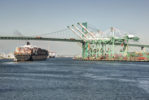
Visit Our Sponsors |
|
|
|
|
|
|
|
|
|
|
|
|
|
|
|
|
|
|
|
|
|
|
|
|
|
|
|
|
|
|
|
|
|
|
|
|
|
|
When it comes to capacity constraints, the year of the rooster is shaping up to be the same as the year of the monkey: tight. According to Adrian Gonzalez, director of the Logistics Executive Council at ARC Advisory Group, Boston, shippers will need to reevaluate their transportation strategies and perhaps redesign their supply-chain networks as demand is outstripping supply for transportation services both nationally and globally.
"Transportation managers are between a rock and a hard place. Rates are going up, service levels are becoming more demanding, and there is no silver bullet that resolves these challenges," he says.
Last year's annual State of Logistics report, compiled by Rosalyn Wilson, found companies paying more money for the same services-and sometimes poorer services. The 15th annual report reported that total business logistics costs rose to $936bn in 2003, up from $910bn in 2002, a 2.9 percent increase. Trucking, which represents more than 50 percent of total logistics costs, rose by $20bn to $482bn (inter-city and local). At the same time freight movements continued to expand. In 2003 U.S. shippers moved 5 percent to 15 percent more product than they did in 2002 while business inventories were up over 5 percent in 2004, said Wilson.
Some shippers are already making changes to address these issues. Toys "R" Us altered its supply-chain network to ship through the Panama Canal instead of congested ports in Southern California. The $11bn retailer imports 90 percent of its merchandise to its 1,259 stores nationwide and an additional 574 stores globally.
"Delays and uncertainties when using West Coast ports would lead to higher inventory levels and earlier buying times," says Marie Robinson of Toys "R" Us. In fact, this Christmas season the company spent $15,000 to divert containers due to port delays in California. Average delay time at Southern California ports was seven days in 2004 while the Panama Canal's delay time was, at most, one day, she says.
The Toys "R" Us strategy is part of a growing trend: Panama Canal traffic is up 8 percent from last year. Dell recently said it will build a new production facility in North Carolina to better serve its U.S. East Coast customers while Wal-Mart, the world's largest retailer, is building a 2 million-square-foot distribution facility near the Port of Houston to avoid West Coast delays. Since 2002, Houston's container trade with Asia has increased from 22,984 tons to 41,584 tons.
| "Rates are up, service levels are more demanding, and there is no silver bullet resolving these challenges." - Adrian Gonzalez of ARC Advisory Group | |
RELATED CONTENT
RELATED VIDEOS
Timely, incisive articles delivered directly to your inbox.






